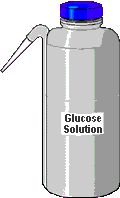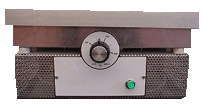|
|
|
Oxygen in Respiration
Oxygen in Respiration
Electrons removed from carbohydrates and other carbon-based biomolecules (lipids, proteins) move down the electron transport system (electron cascade, cytochrome system). At the end of the system, the electrons combine with an electron acceptor to form a stable molecule that completes the series of oxidation-reduction reactions in respiration.
In humans and other aerobic organisms, the electron acceptor is molecular oxygen (O2) from the atmosphere. When electrons reach the end of the system, they combine with oxygen atoms and hydrogen ions to form water (H2O).
In water, a micro-organism has to rely on dissolved oxygen to complete electron transport in respiration. The presence of dissolved oxygen can be indicated with methylene blue. Methylene blue is a dye that is colored blue when oxygen is present. In the absence of oxygen, methylene blue is colorless.
Follow the steps below to see what happens to dissolved molecular oxygen when yeast metabolize an added carbohydrate. Lab materials for this experiment are shown at the right. Click on the first step to begin:
1. Fill the test tube 1/4 full with yeast
solution.
2. Add an equal amount of glucose
solution.
3. Add a drop of methylene blue dye.
4. Put a cork in the test tube and
shake gently by inverting the tube
several times.
5. Remove the cork. Put the test tube
in a beaker of warm water. Leave
the tube in the water for 3 to 5
minutes, or as long as it takes for
any change in color to occur.
When you are satisfied that the contents of the test tube have stopped changing appearance and have reached a stable equilibrium, answer the questions on page 129 of your Lab-Lecture Manual.





![]()
© Mountain View College, DCCCD